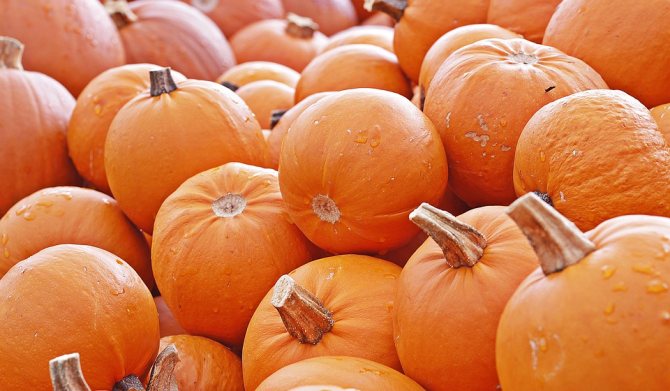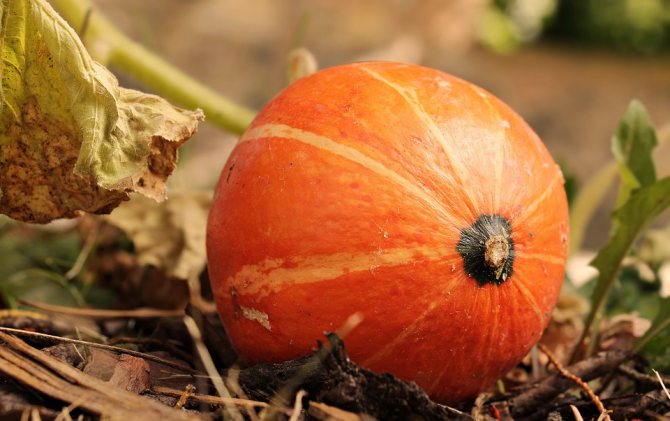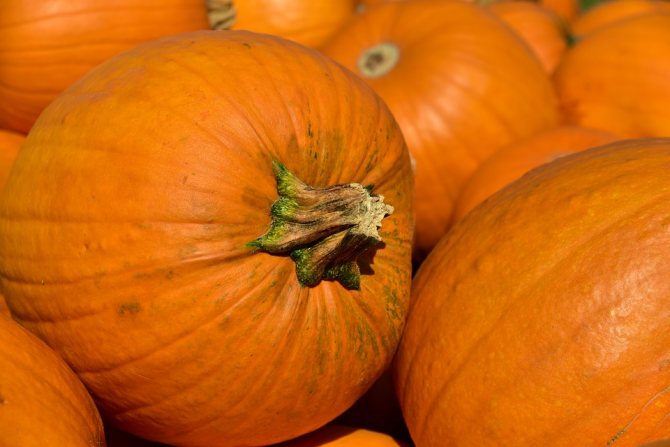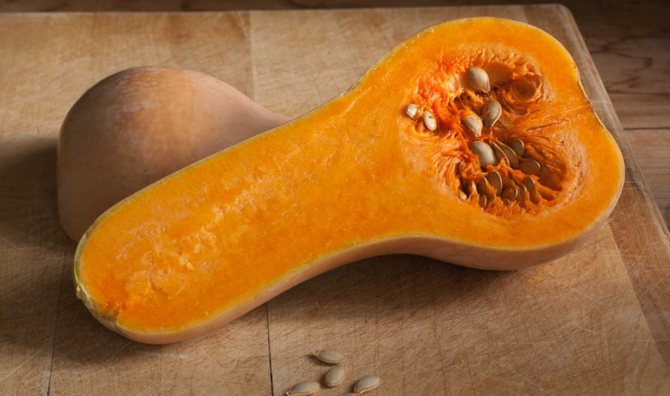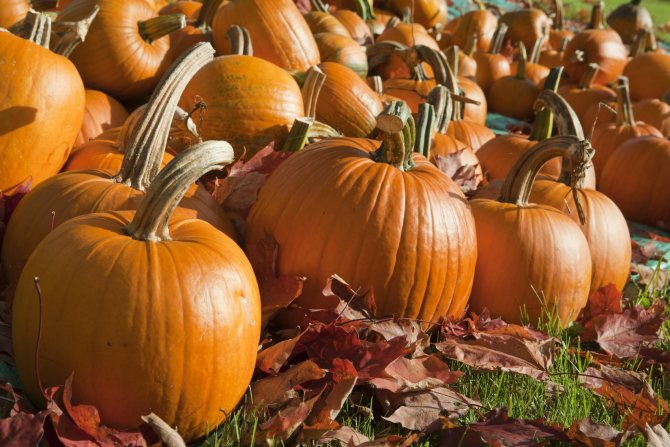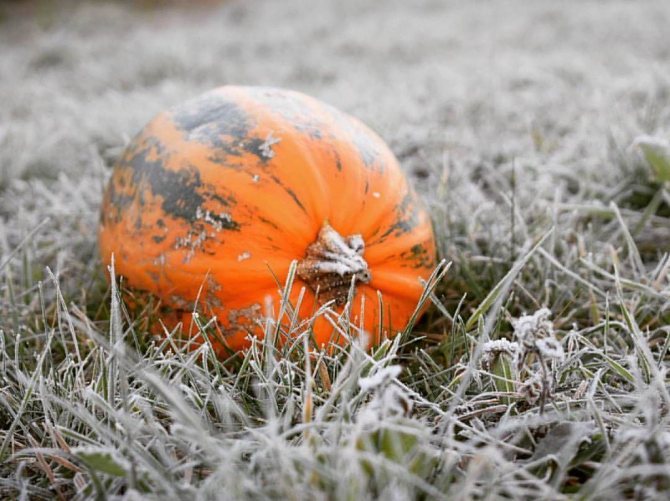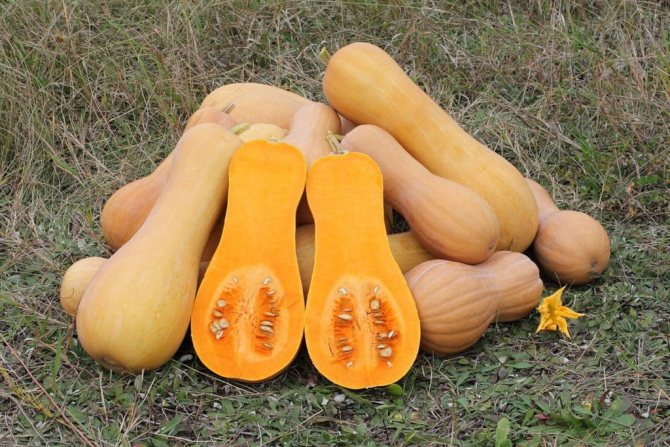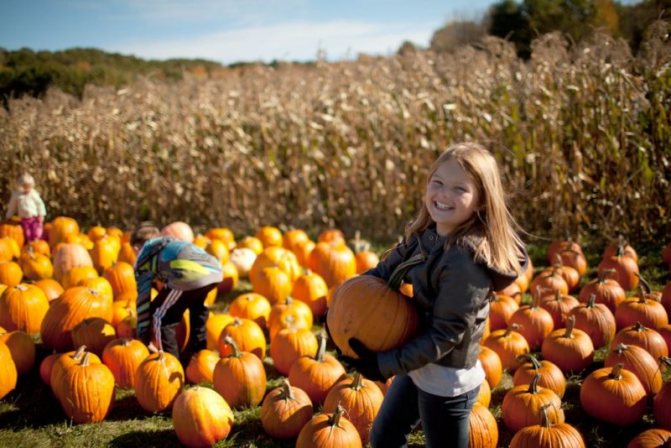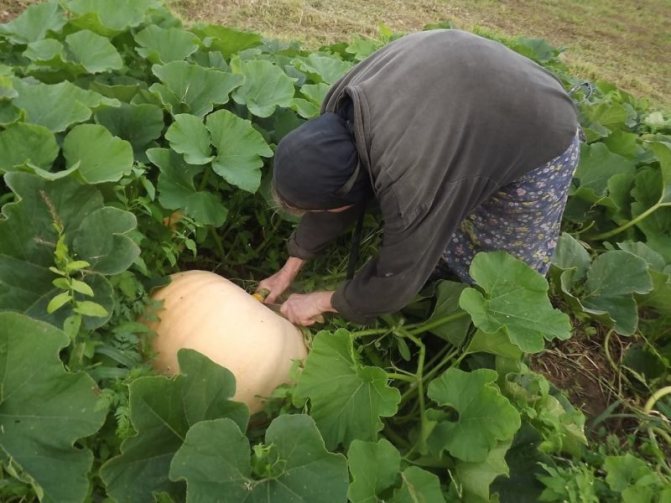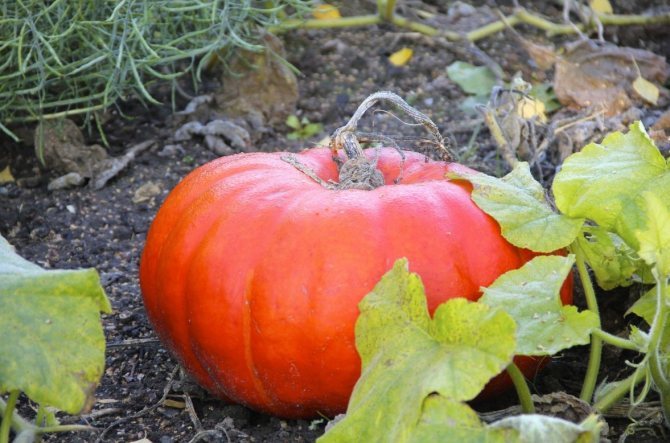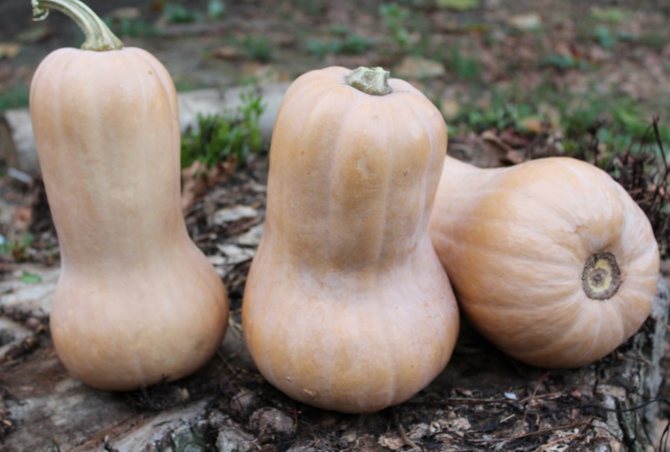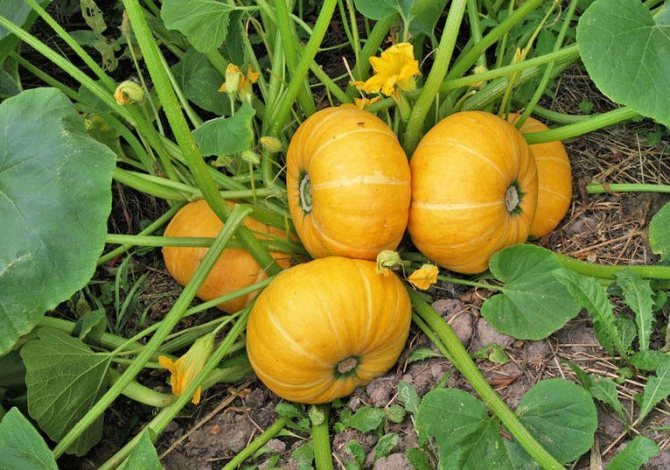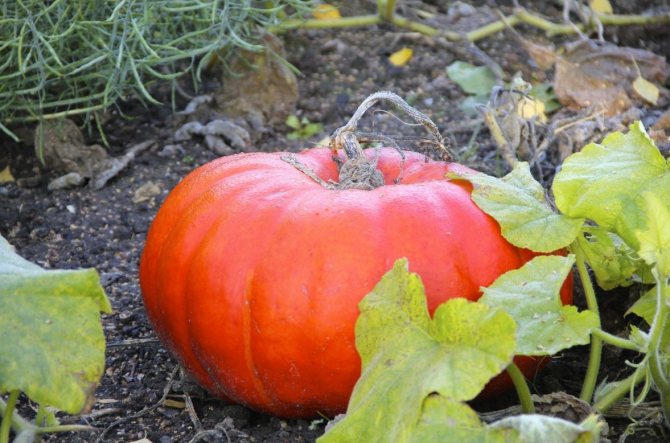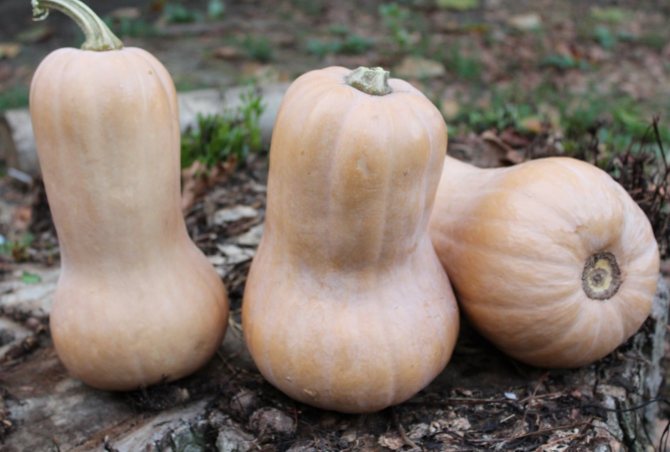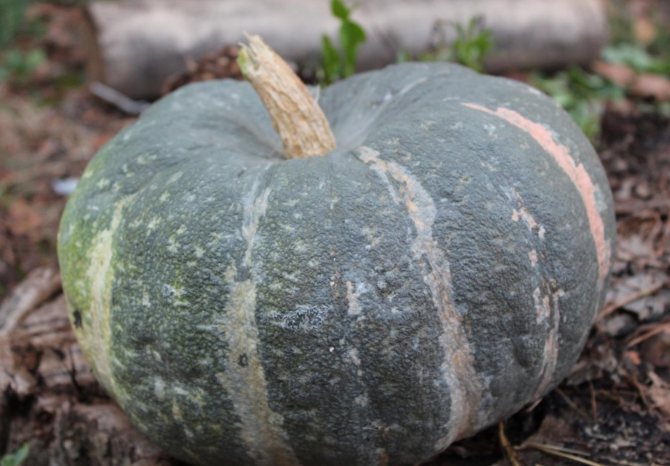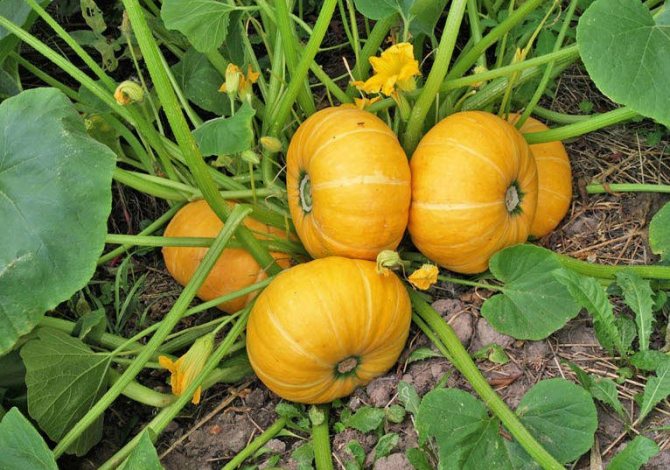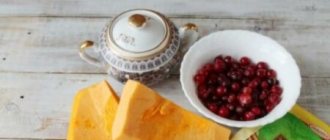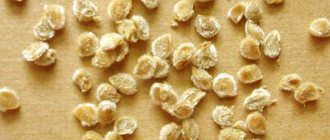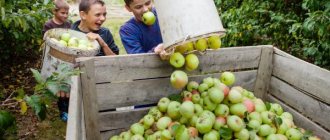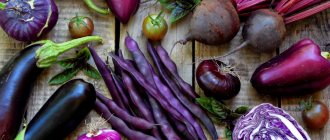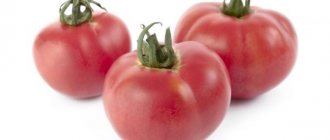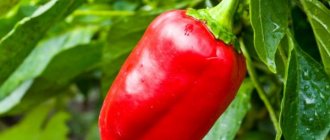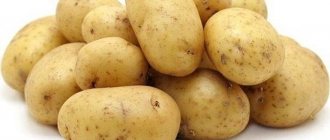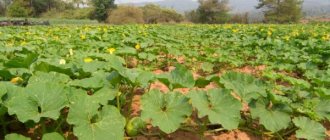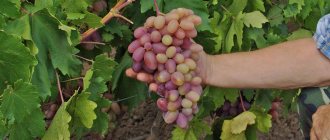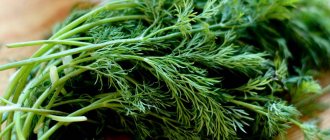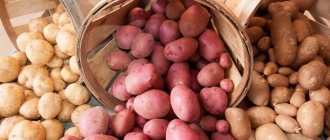Pumpkin is a real garden queen. Bright orange, pot-bellied, sunny - it pleases with only one of its looks. And the taste is simply amazing! Hundreds of different dishes are prepared from pumpkin - juice, jam, pancakes, cereals, pickles, casseroles, candied fruits and a lot of other things. But in order to cook all these dishes, you need a good ripe pumpkin. Unripe fruits do not taste so good, and their aroma is much weaker. So how do you know the ripeness of a pumpkin? It turns out that there are many signs of maturity.
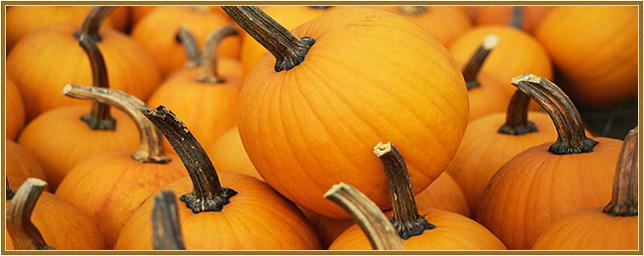
When to harvest pumpkin and how to determine its ripeness
Harvesting in the garden in the fall is the result of all the previous work. Pumpkin is one of the last to be removed from the land, since this culture is quite unpretentious to care for and cold-resistant. But not every gardener knows when to harvest a pumpkin. This article will be devoted to this issue.
Ripening terms
The ripening time of the pumpkin depends on its variety. Today, on the territory of our country (Moscow region, Siberia, the Urals and other regions) the following varieties of this crop are grown:
How to determine the maturity of a pumpkin?
It is possible to determine that the pumpkin is already ripe and it is time to start harvesting it by the following signs:
- The stem of the pumpkin has become dry and tough.
- Leaves and fences turned yellow and partially (or completely) dried out.
- The pumpkin color is brighter and the pattern is clearer.
- The peel has a tough structure, which does not leave a trace after pressing with a fingernail.
- The pumpkin rings when tapped.
During harvesting, care should be taken so as not to damage the integrity of the pumpkin skin, as well as prevent it from falling. From the blows, the pumpkin will begin to rot from the inside during storage.
The removed pumpkin is stored in a dry and cool place (in the basement).
When to harvest pumpkin and how to store it - video
Many varieties of pumpkin allow you to grow this healthy vegetable from Arkhangelsk to Crimea and from the Far East to the western borders of the country. The unpretentiousness of agricultural technology and the size of the resulting nutritive mass make the pumpkin desirable on any piece of garden land. But how to determine the maturity of the pumpkin in the garden, not to be late with the harvest for an inexperienced vegetable grower?
Accelerating the ripening of fruits
Often, in late summer or early autumn, the weather does not pamper with warmth. And I would like to shoot pumpkins mature and large! A few country tricks will help the pumpkin to ripen as soon as possible:
- First, we mulch the pumpkin beds. black film... This material absorbs and retains heat well. Under the film, the soil temperature at the roots of our pumpkin will be 3-4 degrees higher than outside.
- Secondly, we water warm water... If you water the whips with warm water from the very beginning, the pumpkin will grow better and ripen faster. The pumpkin is watered at the root during the day, when both the water and the air are warm enough.
- Thirdly, we treat plants with growth stimulants. Spraying the leaves with Epin, Zircon, Energen or another similar preparation helps the pumpkin adapt to cool weather.
- Finally, we install reflector... To give the ripening fruits more heat and light, you can put a reflective screen made of foil glued onto cardboard or plywood behind the pumpkin.
Effective ways to accelerate ripening
To prevent the vegetable from freezing in the open field in the garden, 21 days before the expected drop in temperature, all flowers from the lashes of the culture are removed. Along with this, you need to pinch the tops of young shoots. This measure will serve to ensure that the plant will direct all the beneficial nutrients to the development of those fruits that have already set. If the plant is dotted with a large number of small fruits, some of them must be removed. This is done so that large units have time to ripen by the time of harvest.
If in the region where the crop was grown, there is a warm summer, but even under such conditions the vegetable does not ripen on time, you can try sowing seeds for seedlings in April. In this case, the planting material should be sent in a deep container. When the seedlings grow 2 true leaves, they are moved to a large container or soil (if climatic conditions permit).
See also How to pinch and pinch a pumpkin in the open field - schemes
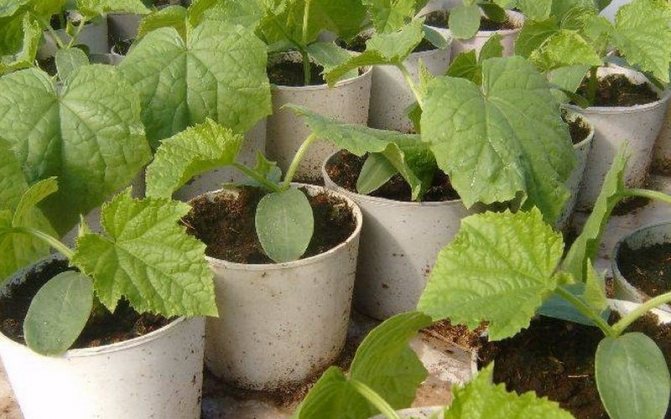

In addition, a compost heap will help speed up the maturation of the crop. Plants erected in such conditions will not lack nutrition and will additionally warm up.
When to remove carrots from the garden?
Someone thinks that carrots can be harvested at any convenient time until mid-autumn, because carrots are such a root crop that is not afraid of cold weather. And someone is of the opinion that the harvesting of carrots should take place strictly on time. So which opinion is more correct? Perhaps this question cannot be answered unequivocally, since each summer resident decides for himself how to properly care for his plants, based on his experience gained after years of observation. But you can still make certain rules about when to harvest carrots.
So, there are certain factors that affect the timing of the carrot harvest:
- variety of carrots (there are three varieties - early ripening, mid-ripening and late-ripening);
- temperature conditions;
- the purpose of cultivation;
- the condition of your plants.
Once you have decided which variety of carrots grow in your garden and by understanding the other factors, you can calculate the ideal timing for harvesting. And, if you determine the timing correctly, then you will always collect high-quality carrots from your garden.
Carrot harvest time
- Late ripening carrots.
So, carrots with late ripening times must be dug out of the ground even before the onset of stable autumn frosts, that is, at the most until the end of September, since when the temperature drops below four degrees, the carrots stop growing, and when the temperature drops to minus, it can become covered with gray rot ... In general, it is advisable to remove carrots from the garden by mid-September. But, which is very important, you cannot harvest carrots too early, because if you store them in the basement, then a sharp change in temperature - warm earth, and then a cold basement - will not benefit the root crop. - Mid-season carrots
... The timing of harvesting a mid-ripening carrot is very easy to calculate on your own, given that the timing of its ripening is 80-110 days. A little knowledge of arithmetic, acquired in elementary school, will help to accurately calculate the harvest time of such carrots. But also a sign of ripening mid-season carrots are yellowed lower leaves. So it is almost impossible to miscalculate the harvest time here. But you need to be careful, because if you overexpose carrots in the ground, then its taste will change significantly and, alas, not for the better. - Early ripe carrots
... Early ripening carrots can be harvested in mid-summer. This carrot is distinguished by its bright taste and juiciness, so it is best to use it for food in its raw form, and use other varieties for any preparations for the winter.
Correct harvesting
Having figured out when to remove carrots from the garden, you should pay a little attention to how to do it correctly. Small root vegetables are assembled very simply - with one hand you need to grab the tops, and with the other hold the carrots in
soil. Long carrots, on the other hand, should be dug slightly before removing them from the soil so as not to break them.
As soon as the soil on the root crops dries up slightly, it is imperative to rid the root crop of the tops, since the tops will draw out all the nutrients from the carrots, which we do not need at all. Leaves can be left only on bunch carrots, and even then, it is better to cut them to a length of no more than two centimeters.
Knowing how and when to harvest carrots, you will receive delicious and beautiful carrots from your garden every year, which can be used in salads, in Korean dishes and for preparations for the winter. And the main thing is that vitamins useful for the body are preserved in the timely collected carrots, so that the carrots will not only be tasty, but also a useful part of your menu.
The number of dishes that can be prepared from pumpkin is infinitely large - the only thing that limits you is your imagination and culinary skills. These healthy fruits are used to make first and second courses, juices, serve as a main course and a side dish.
Ripening pumpkin in different climates
Every experienced gardener relies on the climate in his area when growing certain plants and knows what to expect from each season. For example, late-ripening pumpkins are completely unsuitable for those regions in which cold weather sets in, and the gardener runs the risk of simply not waiting for the full ripening of the vegetable or not having time to extract it in time.
Regions with short and / or cold summers
Those gardeners who are unlucky with the warm summer season are advised to focus on early-ripening pumpkin varieties. As already mentioned, they will take about three months to mature. When planting an early ripe pumpkin, you can be sure that you will have time to harvest a full harvest at the end of August. Overexposing such a pumpkin in the ground is not only pointless, but also dangerous. The stagnant vegetable will become loose and fibrous.
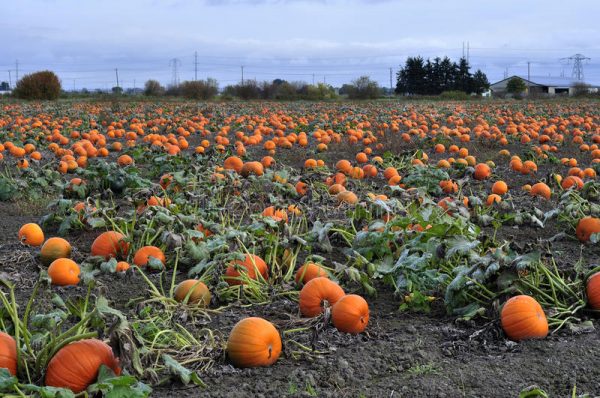

The closer your garden is to the north, the faster your pumpkins should ripen.
Early ripening varieties do not have outstanding palatability and can be consumed quickly. Their pulp is not as rich in nutrients as the pulp of later vegetable varieties. But these pumpkins have their own advantages - they are grown for tasty and healthy seeds.
Regions with a temperate summer climate
Most gardeners in the middle lane are guided by mid-season pumpkin varieties, as a kind of compromise. Therefore, if the above zero temperature does not hold on your site until the end of October, but the climate is gentle enough to allow yourself to keep vegetables until mid-September, a mid-season pumpkin is the best choice. Four months after planting, mid-season varieties are ready for harvest.
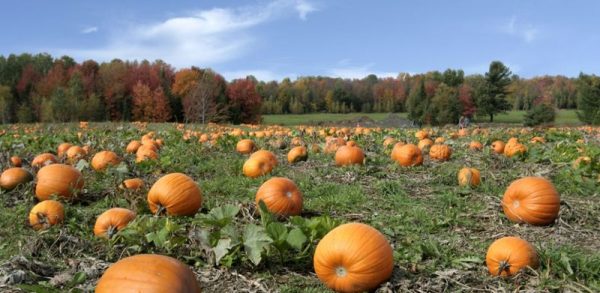

Mid-season pumpkins are best suited for the inhabitants of central Russia
Unlike early-ripening pumpkin, mid-season pulp is more pleasant to the taste and can be safely used in cooking. Mid-season varieties have a whole range of vitamins, since they contain:
Among mid-season pumpkins, one should pay attention to large-fruited varieties that can be stored in cellars for several months. However, long-term storage of such vegetables is possible only if you managed to remove them before the first frost. Otherwise, the shelf life of a mid-season variety is significantly shortened.
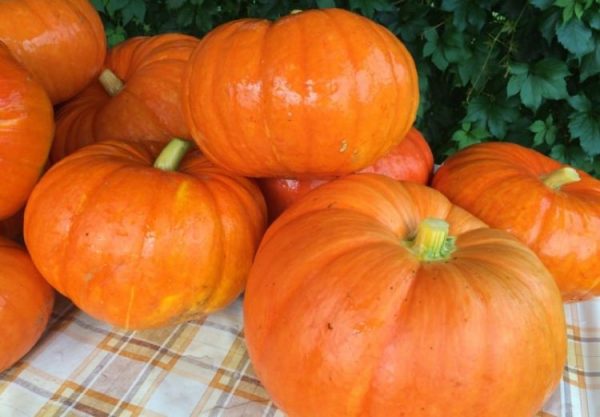

Mid-season pumpkins are full of vitamins and nutrients
The best time for harvesting mid-season pumpkins is the end of September. Harvesting is carried out regardless of whether all the fruits managed to reach a mature state. Those pumpkins that still need time are sent to ripening in the cellars. For the final ripening of the fruit, a dry and warm room is suitable.
Regions with long warm summers
Late-ripening pumpkins can only afford the southern regions, which are not afraid of cold autumn. Of all the late-ripening varieties, it is recommended to choose nutmeg, since they are the most tasty and healthy. Butternut pumpkins are whimsical to care for and incredibly thermophilic, but careful care of them is worth the result.
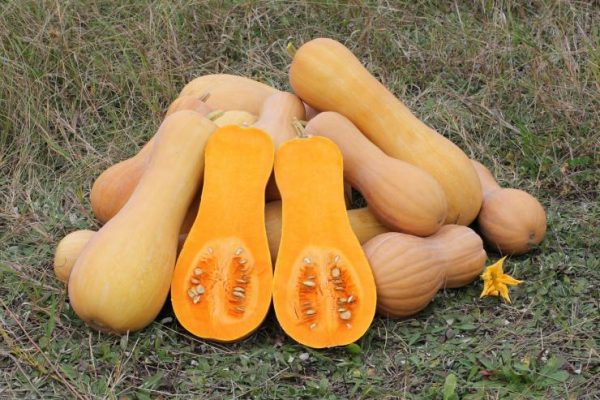

Butternut pumpkins are considered a real delicacy, but very demanding to care for.
It takes more than four and a half months for butternut squash to mature, and some may be harvested in early November. When stored for a long time in the cellar (more than five months), the pumpkin pulp breaks down into fibers and loses its taste.
With a strong desire, the northern regions can also try to cope with fragile late-ripening pumpkins, but you should prepare in advance for the need to ripen them with your own hands for a couple of months. Immediately after maturing in artificial conditions, pumpkin should be quickly eaten or processed.
In order for the pumpkin to give a good harvest, regardless of climatic conditions, it must be looked after during the entire growing season. Read about the basics of proper handling of pumpkins and proper feeding of fruits below.


Features of pumpkin care
In addition to climatic conditions, the condition of the soil in the autumn affects the timing of the pumpkin harvest. The more it is saturated with useful microelements, the faster vegetables are formed inside it and the better they are obtained as a result. You can read about how to fertilize the soil in the autumn season on our website.
Wood ash prices
wood ash
Useful properties of pumpkin
Pumpkin can be called almost the most useful vegetable. It is a source of large amounts of beta-carotene, an antioxidant that strengthens the immune system, helps restore vision, and strengthens nails and hair. Especially a lot of beta-carotene is contained in such varieties as Stopudovaya, Butter Pyshka and Big Max. In addition, pumpkin:
- improves digestive functions;
- removes excess fluid from the body;
- promotes cleansing from parasites.
Pumpkin is great for diet food. The Chenzhou waxy gourd variety is especially good for this. Its smooth, pale green fruit weighs up to 3.5 kg and is rich in antioxidants. Chenzhou contains many seeds, which are almost half of pumpkin seed oil. A jar of this product in the Middle Ages cost several gold pieces. Nowadays, you don't need to be a wealthy feudal lord to afford pumpkin seed oil. With the same success, you can simply eat fresh seeds, which are in no way inferior to him in useful properties.
In order to make the use of seeds much easier, breeders have bred gymnosperms, the seeds of which are not covered with a shell, for example, the Doll-Matryoshka.
Signs of a ripe pumpkin
Regardless of belonging to a particular variety, the degree of maturity of the pumpkin is recognized by universal characteristics. If you are not sure if you can recognize a mature vegetable, dig one pumpkin first and examine it carefully. When examining, be guided by the following details:
In addition to all of the above characteristics, it is useful to focus on the more specific ripening dates stated for specific varieties.Of course, there is no year after year, and if the summer is very warm or very cold, the moment of ripening will inevitably shift, but knowing the approximate time values allows you to prepare in advance for harvesting.
Cabbage - too
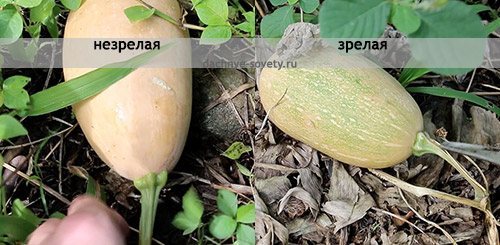

Sudden frosts and white cabbage are not afraid.
Adult plants can withstand a sharp cold snap down to -8 ° С
Its heads of cabbage begin to be cut off at all only after the first autumn frosts, so as not to specially cool them before storing them.
If cabbage heads are not cooled before storage, they will quickly wilt and shoot.
Small freezes are good for cabbage, but if the temperature drops below –8 ° C, the inner leaves of the cabbage will begin to die off. Such cabbage cannot be stored for a long time. It is best to prepare delicious pancakes from it, for example, or canning.
Be vigilant and keep a close eye on the weather forecast to harvest on time. If this was not done, do not be upset, because there are many ways to preserve the fruits in a processed form.
Harvesting rules
Cleaning is carried out in dry weather, after the lashes dry well from the morning moisture. If the weather is charged, you will have to harvest in wet weather, such fruits need to be dried well. Separate the damaged specimens at the same time. In dry warm weather, the root crops cut off from the main stem can still be held on the melon, under the rays of the sun.
All that has been said concerns pumpkin as a food product. There are many other varieties in culture. Loofah pumpkin provides us with excellent washcloths and serves as a filler in the furniture industry. This type of pumpkin is left to grow after frost until the skin is thin.
Decorative pumpkins are used for handicrafts in folk art. Therefore, light freezing does not affect the condition of the crust, and the pulp from these fruits is almost never used. Therefore, ornamental fruits lie in the garden or hang longer than food varieties.
There are certain periods by which gardeners are guided when harvesting. For the southern regions, Crimea, the pumpkin harvest time is the end of September and the beginning of October with the possible ripening of late varieties indoors. These are mainly nutmeg, very tasty pumpkins.
In the Moscow region, harvesting should be completed by mid-September. In this case, you should take into account the weather forecast and avoid delays in picking pumpkins during a cold snap.
Siberia is large and here, as in the Far East, the time when you can pick a pumpkin depends on the regional climatic conditions.
Pumpkin growing video
Autumn is the time for summing up the results of spring-summer work and harvesting. Pumpkin, as an unpretentious and rather cold-resistant culture, is one of the last to be sent for storage. But when is it more correct to do this? Since at the disposal of gardeners today there are more than a dozen varieties of pumpkin with different characteristics and ripening periods, the time of harvesting vegetables largely depends on their early maturity, as well as on the weather and climatic characteristics of the region. When to remove the earliest varieties from the garden, and how much longer late-ripening fruits remain in the garden?
Gathering pumpkin
The timing of pumpkin harvesting directly depends on the further use of the fruit. If you do not plan to store them all autumn and winter, then you need to collect them in a mature form. The biological ripeness of a pumpkin occurs when the stalk dries out. In particular, in nutmeg gourd, the bark hardens, and a pattern appears on it clearly and vividly.
If the pumpkin is intended for long-term storage, it is more advisable to remove the fruits a little unripe so that they gradually ripen during storage.
Damaged fruits cannot be stored, it is better to cook something from them without delay.
When collecting a pumpkin, the fruits should be cut off together with the stalk, in order to avoid rotting of the vegetable. Moreover, it is not recommended to lift the pumpkin by the stalk during transportation. This is especially true for large varieties, since if the stalk or peel is damaged, the shelf life is significantly reduced.
What can be cooked from unripe pumpkins. Can you eat unripe pumpkin?
The dry matter content in pumpkin fruits is on average 6-8%, in the best varieties it reaches 15-20%, sugars on average 5-6%, and in some up to 10%. The amount of sugars varies dramatically depending on the cultivation area of the pumpkin. The amount of starch reaches 2-7%. Before ripening, it is most of all in the fruits, then the starch content decreases, in the maturation it disappears completely. Pumpkin fruits also contain vitamin C, carotene, nitrogenous substances, organic acids, fiber, pectin substances, a number of ash elements, and seeds - up to 41-48% fat.
From the moment the fruit ripens, the dry matter content slowly decreases with an increase in the amount of sugars and pectins. The higher the percentage of starch in the pumpkin, the better it is stored and the more sugar it becomes during storage. The higher the concentration of carotene, the more intense the color of the pulp.
The chemical composition of fruits changes significantly during storage, when part of the carbohydrates is consumed for respiration. In this regard, the amount of sucrose in the fruit decreases. With prolonged storage in the pulp of pumpkin fruits, a relative increase in pectins and fiber occurs due to a decrease in sugars and starch.
The consumption period is longer than that of watermelons and melons. Pumpkin can also be eaten unripe (for example, in salads), but, as a rule, it tastes much better when it lasts a little.
How to determine the early maturity of a pumpkin
Cultivated pumpkin varieties belong mainly to three botanical types: butternut pumpkin, large-fruited and hard-bore pumpkin.
Large-fruited pumpkin varieties are mostly mid-season and late. This pumpkin has the largest fruits - up to 70 kg or more. They have a fibrous, loose flesh and retain their high taste for up to 10 months.
Hard-bore pumpkin varieties are early ripening and less heat-demanding compared to other varieties. Their fruits are usually medium-sized. These pumpkins begin to bloom earlier than others, they fill up rather quickly and at the end of August - in September they are already ready for consumption.
The varieties of butternut squash are highly palatable. They are distinguished by their late maturity and thermophilicity. Most varieties of this species are distinguished by a high carotene content, good pulp quality, high yield and keeping quality of fruits. They are used in the canning industry to obtain carotene, baby food and juice. The fruits are long, elongated in shape. When ripe, the bark turns pink-brown and yellow.
When to harvest pumpkin
The pumpkin is harvested in dry weather, before the onset of frost, with the full ripening of the bulk of the fruits, usually in September, and in the south - with the complete death of the leaves.
Only in some very late-ripening varieties of the Stolovaya type, winter fruits are harvested unripe (they ripen during storage). The ripeness of fruits in varieties of large-fruited pumpkin is determined by a dried and corky stalk, and in hard-bore and nutmeg pumpkins - by a change in the color and pattern of the fruit bark. When harvesting, it is necessary to keep the stalk 3-4 cm long and avoid damaging the fruit. Pumpkins harvested in rainy weather must be dried.
What do they eat pumpkin with?
Carotenoids, which pumpkin is rich in, are fat-soluble substances, and for their better assimilation by the human body, it is advisable to introduce butter and milk into pumpkin dishes. To increase the nutritional value and taste of dishes, semolina or rice groats are added.
Salad
Peel the pumpkin, remove the seeds, grate on a coarse grater with the apple.Add lemon or other juice, sugar, sprinkle with chopped nuts or toasted and peeled pumpkin seeds.
Tips from experienced gardeners
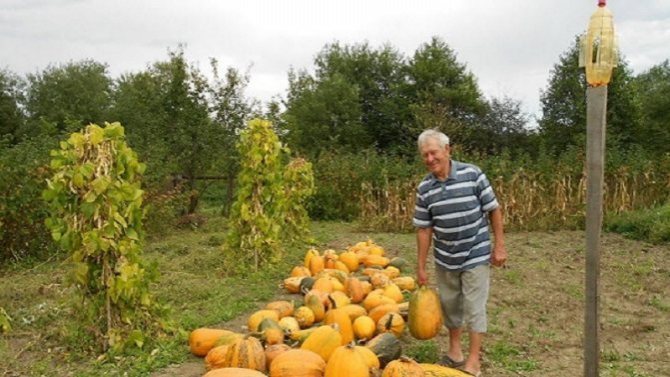

Growing pumpkin has its own tricks:
- The last time to water the vegetable should be 3 weeks before harvest.
- In rare cases, you can check the ripeness of the pumpkin by pressing on it with your fingernail. If the peel is pressed through and is green inside, then it is not ripe. But such a check is fraught with rotting of the whole fruit.
- If there is not enough storage space for vegetables, you can cut the pumpkin into slices and freeze it. Such a blank is used for the preparation of all dishes, except for pumpkin juice. Drying and drying of vegetables is also popular.
- The pumpkin should not be kept until spring. In this case, it begins to stale and become "cottony", losing its taste and juiciness.
- If the season was cold and rainy, harvest time has come, and the pumpkin is not yet ripe, you can speed up this process. 3 weeks before the first frost, all the flowers from the pumpkin must be removed, and the tops of the young shoots must be pinched. To accelerate the ripening of large fruits, all small pumpkins are removed from the bush.
Harvest storage
There is an opinion that pumpkin has the property of being stored for up to 2 years, but this largely depends on the conditions of temperature and humidity. In this case, the chemical composition of the fetus can change dramatically.
Important rules must be observed that will significantly increase the safety of the crop:
- all the fruits must not be thrown into a heap: they must be arranged in rows with the stalks upward, and the aisles must be covered with hay or straw;
- be sure to put something under the vegetables: it can be blankets, boards, straw, hay;
- it is important to get rid of rodents before storing, because they will surely enjoy the harvest, destroying it;
- it is necessary to check the fruits for damage - vegetables with them must be consumed first of all, because such pumpkins will not be stored for a long time and can infect neighboring ones.
During the storage period, the vegetable loses weight due to moisture loss, therefore, they often resort to creating stocks using canning, freezing, drying.
By following the basic tips for determining the ripeness, harvesting and storing the pumpkin crop, you will be able to preserve the fruit until the next season, and perhaps even until the next ripening period. Having collected ripe healthy fruits, you also get strong seeds suitable for future planting.
Frozen apples become tasteless
Frozen apples are unlikely to be preserved for a long time. Such fruits lose their taste and aroma, and their pulp becomes sluggish. Most often they are no longer suitable for fresh consumption.
It is better to make jam or compote from frozen apples
In order not to lose a significant part of the harvest, collect the frozen fruits and put them into processing.
- Apples for the winter: 15 great ways to harvest
The best apple preparations for the winter!
Features of harvesting fruits
When the crop is harvested, everything is harvested at once, without leaving it to ripen. They can be eaten immediately or made for winter preparations, but many gardeners leave vegetables to be stored for the winter, because pumpkin is a great help in winter. Rich in vitamins, it will be an indispensable element in many dishes.
For long-term storage of the pumpkin when harvesting it from the garden, it is important to leave the stalk 4-10 cm long. If you remove the stalk, the vegetable begins to be affected by bacteria and deteriorate. After harvesting the pumpkin, it must be dried under a canopy in the fresh air for better storage.
Collection of vegetables. Terms of harvesting table beets, carrots, pumpkins, rutabagas.
Harvesting dates for table beets:
As you know, the timing of the collection of table root crops depends on many factors such as: the goals of cultivation, the climatic conditions of the region, as well as on the characteristics of a particular plant variety.With the onset of September, do not rush to remove everything from the beds as soon as possible, since many late vegetables are still ripening, so it is recommended to start harvesting closer to the end of the month. First of all, beetroot is harvested, and after it, start picking carrots. The reason for this order of assembly is the great thermophilicity of beets, while carrots are less demanding in this regard. Beets are most sensitive to autumn frosts, for this reason they are harvested before or immediately after the first ones. When you remove the beets, it is better to curl the leaves than to cut them off. If you did everything correctly and harvested your beet harvest on time, you can use it all year round, since it has good keeping quality and you should not have any problems with storage.
Carrot harvest time:
Carrots are not very whimsical to fluctuations in temperature, but what really negatively affects it is the changes in soil moisture, especially if these drops are sharp, the carrots can begin to crack. Even if you notice cracks only on a couple of carrots, all of it should be immediately removed from the garden. But when it is dry and moderately warm outside, do not rush to harvest. When the temperature drops to +4 ... +5 ° C, the growth of root crops stops, yellow leaves are also a signal that it is time to start picking carrots. They collect it by digging it with a shovel, but it is worth remembering that it is very sensitive to any damage, therefore, damaged fruits rot very quickly, which makes it impossible to store them for a long time, so it is worth wielding a shovel with particular delicacy. The harvested carrots are cooled before laying in a permanent place, stored for a couple of days, covered with straw or dry foliage, in small piles. For storage, it is worth taking away undamaged root crops, previously cleaned of leaves and soil.


Rutabaga harvest time:
After we removed the beets and carrots, the time has come to the turnip, it is harvested at the very end of September or at the beginning of October, before the onset of stable frosts, at this time, parsnips, root parsley, radish, turnips and celery are also harvested. Earlier, it is not worth harvesting, since in September there is an increased increase in fruit. And fully ripe vegetables are much easier to store in winter ... They dig out the plants with a pitchfork or a shovel, but it is worth doing this very carefully; after digging up the roots, they shake off the soil and cut off the leaves. And in rutabagas, it is better to curl the leaves than to cut them off. It is not recommended to dry root crops in the sun before placing them for permanent storage, as in the sun they can evaporate moisture, which in turn will lead to worse keeping quality during storage. It is better to use damaged and small root crops immediately, for example, for livestock feed, and only large healthy fruits should be stored. For better storage, a small layer of moistened sand can be poured under the root crops, and they can also be stored in the basement during the potato harvest.
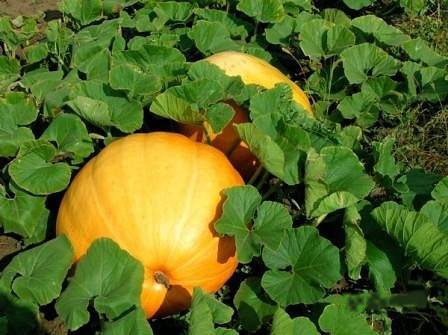

Pumpkin harvest time:
The pumpkin is harvested in clear and dry weather, when it is ripe, the pumpkin does not like frost, so it is worth removing it before they come. The main sign that the pumpkin is already ripe is when the stalk begins to dry out. The fruit should be cut with the stalk. To better preserve the pumpkin, it needs to be dried and heated in the sun for a period of just over a week. On cold nights, cover the pumpkin with something warm. Damaged fruits are not suitable for storage; it is better to immediately put them on feed for livestock.
Pumpkin cleaning and storage. Cleaning and storing pumpkin
The pumpkin harvest is often so generous that you have to think about its long-term storage. But in order for the fruits of this valuable vegetable to be stored as long as possible, the pumpkin must be harvested correctly and on time.
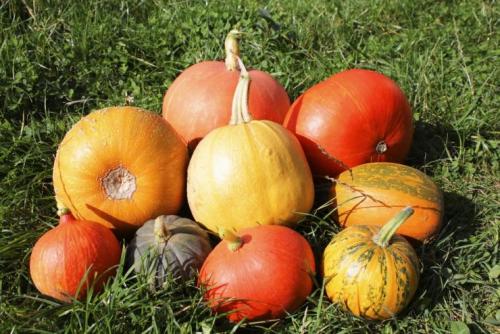

When to harvest pumpkin
In order to preserve the healthy fruits of the pumpkin until the next harvest, it is necessary to remove it from the garden correctly and at the right time.Most often, pumpkins are harvested in one go, trying to maximize the harvest time until the first frost. Earlier picking is allowed only for late-ripening pumpkin varieties, which are harvested slightly unripe to avoid frost damage. The very first and main mistake of any novice gardener is collecting unripe pumpkin. Pumpkins harvested ahead of time will not lie for a long time, they will soon begin to rot, and you will simply have to throw them away.
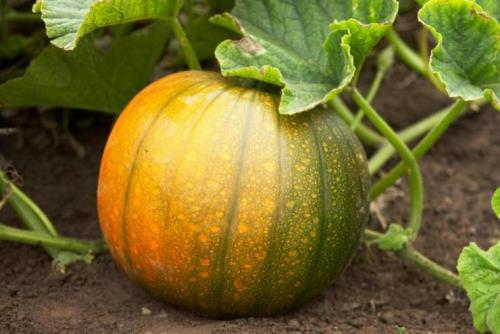

Is it possible to harvest pumpkin in the rain
It is very important to carry out cleaning in dry weather and it is desirable that it does not rain at least a day before harvesting. All watering should be stopped completely about 9 days before harvesting - the soil should be absolutely dry. If you have to harvest the pumpkin in the rain, then dry it thoroughly before storing it. Be sure to keep the harvested crop in a dry and well-ventilated area for a week, placing something soft under the fruits, for example, dry sawdust or burlap.
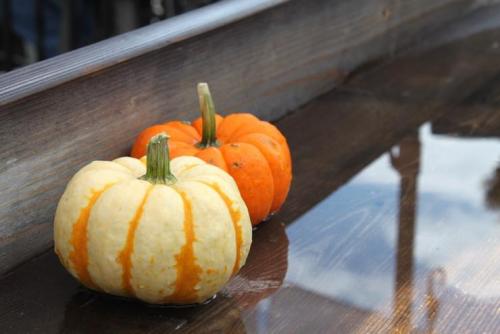

How to tell if it's time to harvest your pumpkin
If you have a large-fruited pumpkin growing on your site, then carefully examine the stalk - in a ripe fruit it should be completely dry and corky. If you have planted a nutmeg or hard pumpkin, then pay attention to the pattern on the bark - it usually changes significantly by the time of full ripeness, becoming like the bark of a tree. The color of the bark of a ripe pumpkin becomes more uniform, saturated, and the skin acquires a noticeable hardness. To determine the ripeness of the fruit, you can conduct a small experiment: scratch the skin of the pumpkin with your fingernail in one place. If scratches are easy to apply, and a trace remains from the nail, then this fruit is not yet ready for harvesting.
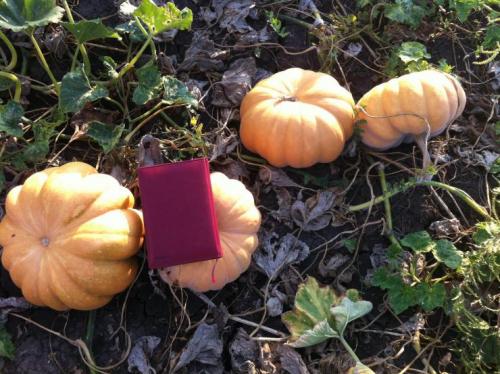

How to properly harvest pumpkin
The pumpkin will not rot during winter storage, if you follow simple rules when harvesting.
- Collect the pumpkin as carefully as possible. Women are advised to wear soft gloves to avoid damaging the pumpkin skin with their nails.
- Do not throw fruit even on a soft surface.
- Do not tear the fruit off the stalk by grasping it tightly with your fingers, as you can injure the surface without even noticing it.
- Use a sharp, clean knife or pruning shears to cut the fruit off the stalk.
- Be sure to leave a part of the stalk 12-15 cm long.
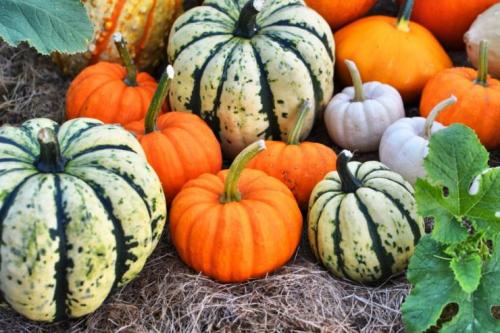

How to store pumpkin
Before leaving the pumpkin for storage until spring, it is necessary to sort all the fruits cut from the lashes, focusing on volume. Set aside large vegetables to one side, medium ones to the other, small ones to the third. I advise you to select large and medium pumpkins for storage. Before storing the pumpkin in storage, check again for rot and other damage on the fruit.
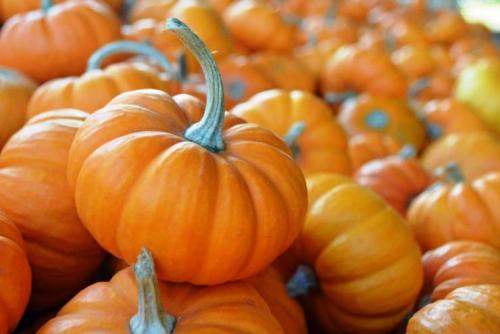

Where to store pumpkin in winter
The pumpkin will stay fresh all winter if you follow the recommended storage conditions - temperature and humidity conditions. The first week after laying, the pumpkin should be stored at a temperature of 25-28 ° C and an air humidity of 80-85%. Under these conditions, unripe fruits will fully ripen, their skin will harden, and small scratches that you may have overlooked will heal. If you notice deep damage on the pumpkin already in storage, then try to heal them by treating with 3% potassium permanganate. If the air humidity in the storage is low, then rot and various bacteria will develop much more slowly! After a week, the pumpkins should be moved to a dry and cool place, preferably with very good ventilation. Optimal conditions for long-term storage of pumpkin: temperature 4-9 ° C and air humidity about 70%.
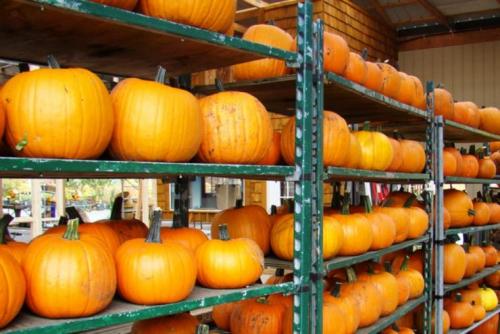

How to store pumpkin properly
- Pumpkins should not touch each other, air should circulate freely between them!
- It is most convenient to place the pumpkin in the storage on the shelves.
- Put straw under the pumpkins, provide the fruits with space, and they will sleep in a sound, healthy sleep until spring.
- Do not forget to visit your harvest at least every 2-3 days - this way you can see and remove suspicious and starting to deteriorate fruits from the bookmark in time, because other pumpkins may suffer because of them.
- I do not recommend storing pumpkin next to apples or pears. The fact is that any fruit "breathes" very actively, releasing ethylene, which leads to a reduction in the shelf life of both pumpkin and other vegetables.
- Well, according to my observations, pumpkin varieties such as Almond 35, Mozoleevskaya 49, Premiera and Gribovskaya winter are best preserved.
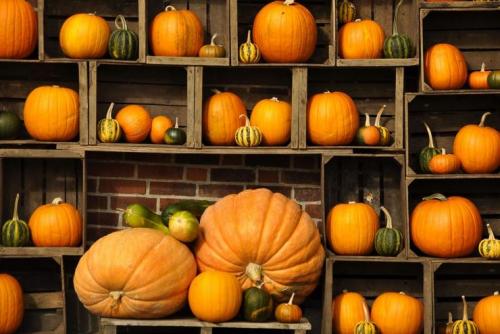

Harvesting calendar dates
Pumpkin harvesting dates depend on the local climate and plant variety:
- in Siberia, the harvest is taken from the end of August;
- in central Russia and Ukraine - in mid-September;
- in the Krasnodar Territory - until early October.
The pumpkin should be harvested on a clear, dry day. It is desirable if it coincides with the date of collection according to the lunar calendar.
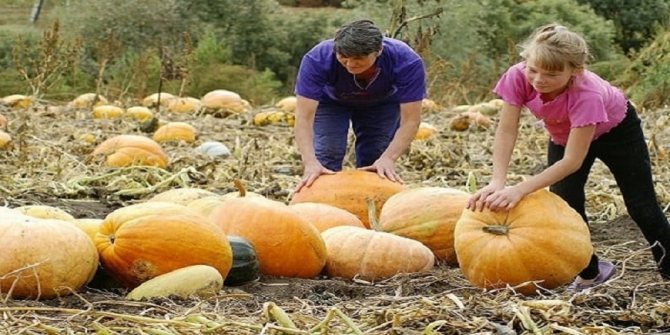

Lunar cleaning
Experienced gardeners carry out all the work on the site, according to the lunar calendar. It turns out that even harvesting has its auspicious days - during this period, all the juices of the plant move to the fruit, saturating it and giving it taste.
The lunar calendar changes every year. The most favorable dates for harvesting pumpkins will be the days when the Moon is in Gemini in a waning phase, Scorpio in a waning phase, Sagittarius, Capricorn and Aquarius in any.
Pumpkin harvest
For gardeners living in the southern regions, pumpkin harvesting is easier, since pumpkins have time to ripen directly on the plant. In colder regions, gardeners have to harvest pumpkins before they reach maturity and put extra effort into caring for the vegetables. In both cases, it is necessary to correctly remove the pumpkin from the soil, avoiding damage and other unpleasant consequences.


Before harvesting, carefully study the forecast for the coming days.
To maximize the shelf life of the fetus, observe the following guidelines:
- The ideal weather conditions for harvesting will be the absence of precipitation and high (for autumn) air temperature;
- Moving the pumpkin must be done very carefully. Despite the fact that mature vegetables have a very hard bark, if they fall to the ground and other scenarios of inaccurate handling, pumpkins will be damaged and will last much less. The delicate pulp is prone to deformation and rapid decay. In addition, pathogenic bacteria easily penetrate into scratches, after which the vegetable can only be disposed of;
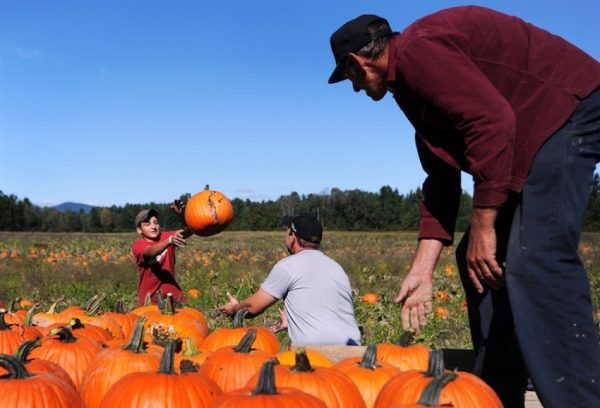

Despite the hard bark, pumpkin can crack easily if dropped
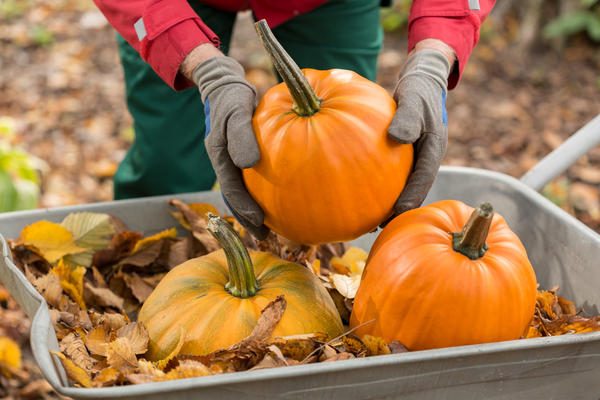

You need to take the pumpkin by the bark itself, the handle is not intended for carrying the fruit
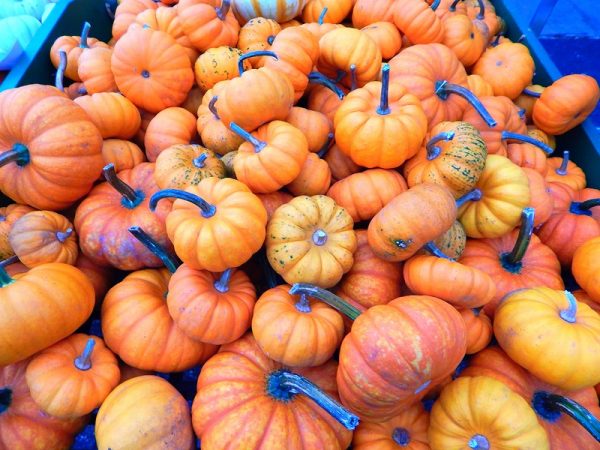

After removing the pumpkin from the soil, it must be dried.
Video - Features of the pumpkin harvest
What temperature is fatal for a pumpkin. In what conditions are they stored?
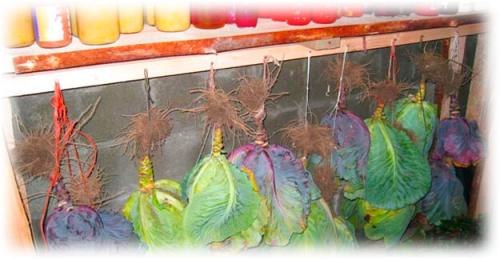

How long a vegetable can be kept unprocessed depends on the type of crop and how it was stored. One of the important conditions is at what temperature to store the pumpkin. Too low temperatures are detrimental to any varieties, since keeping in the cold threatens to freeze and reduce the shelf life of the pumpkin by 3 or 4 months.
It is allowed to store a pumpkin in an apartment or a cellar area, subject to a temperature balance of 3 to 15 positive degrees, which will be the most comfortable for a guest from the garden.
Humidity should be around 75 or 80 percent. With an increase in this level, the bark of the plant will become overgrown with cobwebs, mold, or spots will appear, which indicates the defeat of the vegetable. Spoiled copies are disposed of so that the infection does not spread further.
It is not so important where you can store the pumpkin in winter, how much the observance of the optimal conditions for keeping the ginger vegetable, adhere to the desired temperature and humidity, check that the room is not damp and it is well ventilated. There should be no direct solar radiation, as well as dustiness, debris.
The vegetable should not be wrapped in a plastic or cellophane bag; condensation formed inside the package will lead to infection of the crop with a harmful fungus. Each fruit should be covered with parchment paper or dry straw in a small layer.
Tip: Do not allow vegetables to lie tightly pressed against each other or the wall. The optimal distance is considered to be intervals of about 10 centimeters.
The litter is periodically damp and replaced with a dry one. The fruits should be positioned so that the stalks are at the top. If the pumpkins are stored in a place where frost can penetrate, they are covered with bedspreads or other insulation.
Knowing how to store pumpkin indoors will help preserve the vegetable until the spring months. You can keep the crop in a cool pantry on the floor or shelves. If there is none, choose the least warm place in any room, for example, put pumpkins under the bed. Copies with dark spots on the peel are not subject to storage. Such a fruit is isolated from the rest, it is thrown away or, having cut off the spoiled places, is eaten.
How to keep your pumpkin harvest in winter
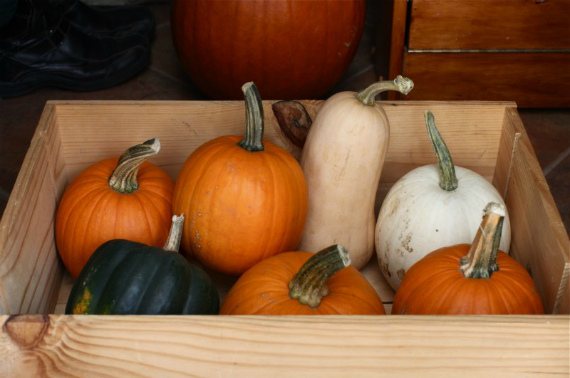

Even a fully ripe pumpkin, harvested in favorable weather, can rot if storage rules are violated. For a vegetable, a storage is selected where a positive temperature and a certain humidity are maintained.
General storage rules
Immediately after harvesting, pumpkins are kept warm for about a week, at a temperature of +22 +25 degrees and a humidity of 70-75%. In such conditions, all the scratches on the skin dry up, the cut on the stalk becomes corky.
For permanent storage, the fruits are removed to a cooler room, with a temperature of +8 degrees and a humidity of no higher than 70%. This can be a pantry, cellar or basement.
What vegetables (fruits) pumpkin is not recommended to store
The pumpkin should not be placed in the same room with ethylene-producing fruits. This is a gas that provokes accelerated ripening, causing premature spoilage of the vegetable. It is not advisable to store pumpkin in the same room with such crops: apples, pear, quince, apricot, melon, fresh tomatoes, potatoes.
You can store pumpkin next to root vegetables (carrots, beets).
Methods for storing pumpkins in an apartment, in a cellar
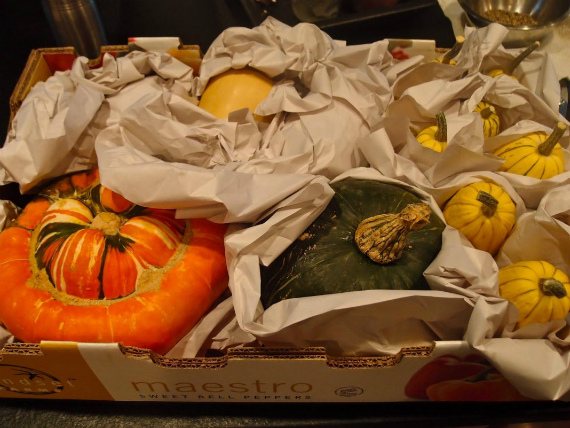

The pumpkins in the cellar are positioned so that they do not come into contact with the skin with each other. Usually, the fruits are placed on wooden shelves, keeping the distance between the pumpkins at 7-10 cm.
If there are a lot of fruits and they need to be folded compactly, thick paper is laid between them (several layers of newspaper). Pumpkins can be stacked on top of each other, but no more than 3 layers. The vegetable is not placed on the ground or on the concrete floor; wooden grates or plywood sheets are used.
Advice... Instead of paper for sandwiching, you can use coarse wood chips, well-dried straw.
In a city apartment you have to keep the crop at a higher temperature than recommended. The fruits can be stored at +18 +20 degrees for several months without compromising quality.
The pumpkin is placed in cardboard or wooden boxes, shifting with paper, cardboard or sprinkling with sawdust. The boxes are placed in the coolest place in the apartment (pantry, corridor), but so that icy air does not get on the vegetable (for example, from the balcony door). The crop is not placed near heating batteries so that it does not deteriorate.
If the harvest is large, and it is not possible to place all of it in the apartment, some of the fruits are allowed to be processed. Pumpkin can be:
- dry, cut into thin plates and remove the peel;
- freeze;
- processed into jam, juice.
Best Stored Pumpkin Varieties
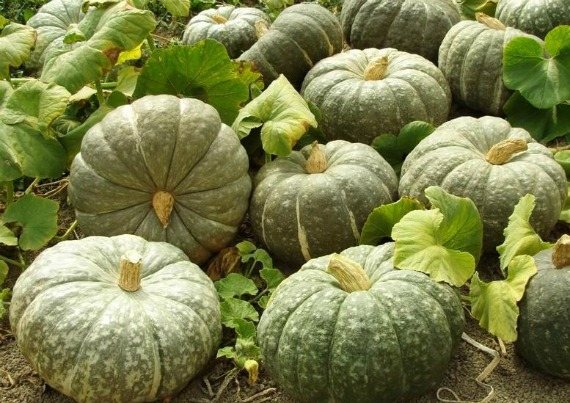

Pumpkin variety Winter sweet
As mentioned above, late-ripening or mid-ripening hard varieties are considered the best for storage. Due to the dense shell and low-juicy pulp, such a pumpkin is less susceptible to rotting and more easily tolerates the adverse effects of the environment.
According to the reviews of experienced gardeners, among the long-stored pumpkins, the following varieties are in the lead:
- Gribovskaya winter;
- Volga gray;
- Pearl;
- Winter sweet;
- Chit;
- Wax (Benincasa).
The specified pumpkin can lie, without loss of quality, up to 1.5 years. But other, even early pumpkin varieties are successfully stored in suitable conditions for 2-4 months.
External signs of a ripe fruit
The pumpkin has certain external criteria, indicating that it is time to harvest. These include:
- dried and hard peduncle. If it still has a green color, the pumpkin must be allowed to ripen;
- at least partially yellowed and dried lashes;
- the vegetable has become bright, has a rich color depending on the variety: orange, yellow, green or gray-green;
- the fruit crust is tough and firm. When pressing on it, there should be no traces;
- on top of vegetables of all varieties, except for green-fruited, a clear pattern is visible;
- the pulp is in appearance with a dense structure;
- hard seed skins, with the exception of gymnosperms.
You can check the last two signs by cutting one of the grown fruits. All of the above is a guarantee that the crop is ready for harvest and can survive for several months after it. If there is such a situation that the pumpkin needs to be removed before its real ripening period, then such vegetables should be put for ripening and only then put away for storage.


It is necessary to collect pumpkins in warm weather, in clear and dry weather.
Individual signs of pumpkin ripening
Each vegetable has its own characteristics, depending on the variety. They need to be considered when it comes time to harvest. First of all, you should pay attention to the stalk. When the fruit is fully ripe, the place of its connection with the stem dies off, gradually becoming hard, like real wood.
In bush varieties, the bark changes from green to yellow or orange with light yellow stripes. Paying attention to this feature, it must be borne in mind that there are varieties that do not change color with the onset of full maturity. These include pumpkins with white or gray bark, such as Butternut or waxy varieties. A large-fruited pumpkin has a dark, dense mesh.
In addition to color, the hardness of the bark will tell about the ripeness of the culture. It becomes so dense that it is almost impossible to leave a scratch with a fingernail on the surface of the fetus. The bark of the nutmeg varieties becomes brown with light round spots.
When the growing season ends, the pumpkin begins to drink all the juices from the stems and leaves. Because of this, they begin to quickly darken, turn yellow and dry. If this is observed, then the fruit is in the final stage of its ripening.
Some summer residents recommend checking the ripeness of the fruit by tapping. If a sonorous sound comes out, then the pumpkin is ripe.


To make sure that the pumpkins are ripe, one of them can be cut
How to properly care for a pumpkin before harvesting?
Regardless of the size of the fruit and the timing of harvesting, there are rules that will help protect the fruit in the garden from decay and pests. Lying constantly on its side, in contact with the ground, in wet weather, a huge berry can rot and become unusable. Wrong to do those who are trying to process pumpkin with a rotten side. Before the fruit has received visible damage, changes have already occurred in the core, and it should not be eaten.
The pumpkin should be placed on a hillock or a specially arranged mound, a wooden or plywood board should be laid down, and covered with a film on top during autumn rains. In the last month, when the pumpkin is gaining sweetness, you need to stop. The length of the roots, which go up to three meters deep, is sufficient to provide the required amount of water.
Indicates that the pumpkin harvest time has come, the first cold snap, since even a slight frost makes the fruit unfit for storage. You can also hold the fruit in the garden in dry weather, covering it from cool nights.
When can you pick a pumpkin?
It is possible to get a fully ripe pumpkin from the field only in hot regions, when the fruits naturally ripen in the field for more than 4 months. But pumpkin is good because in addition to a long shelf life of several months, it still continues to ripen.
Therefore, you can find out if the pumpkin is ripe and how long it can still lie on the ridge, knowing the main signs of the vegetable's readiness for harvesting:
- The leaves of the bush withered, changed their color to yellow, dried up. If before that there were no signs of anthracosis disease, then the natural death of healthy foliage is a sure sign of the end of the growing season.
- The stalk becomes stiff, the top layer is corked, it woods up simultaneously with the stem supplying food. It is no longer possible to shift the pumpkin in another way without violating the integrity of the liner.
- The color of the pumpkin, whatever it is, from gray to yellow, becomes brighter, the pattern is more noticeable.
- There should not be traces of scratching with a fingernail on the crust. The cover hardens and does not spring from pressing with fingers. A ripe pumpkin responds to cotton with a ringing sound. Ripe pumpkin is covered with a matte coating, the stalk is easily separated.
When harvesting a pumpkin, you need to treat it carefully, trying not to scratch it. If there is a problem, seal the place of damage with a bactericidal plaster or do not leave the damaged vegetable for storage.
A removed pumpkin in a dark, cool and dry place can ripen for about a month. You can store the fruit in such conditions for a long time, allowing you to use a fresh healthy product during the winter.
It is very important to use zoned varieties of different periods of reaching biological ripeness in different regions. But even the most mature in about 4 months. Therefore, in regions with a temperate climate, a seedling method of growing is used. A new way in the northern regions was to use mini-greenhouses with biological heating, leaving the root system constantly warm, and whips in the short summer, releasing it into fresh air.
Early ripening varieties are harvested at the end of August, growing by seedlings. These varieties include the common Gribovskaya bush, Freckle, Golosemyannaya. They have a thin crust, shelf life up to a month.
Varieties of average ripening pumpkin - Smile, Healing, Russian woman ripen in 4 months. Harvest in September, but before the first frost. Frozen fruits are not suitable for storage.Varieties of these pumpkins last up to two months after the onset of ripeness.
The most valuable fruits are late-ripening varieties grown under the southern sun. These include, Muscat, Pearl. These pumpkins have a thick, hard rind and sweet pulp, which is added raw to salads. Late varieties are stored in a cool room for up to six months. They are harvested late, but even in the south, ripeness occurs in a month or two.
The ripening dates indicated on the seed bag are for ideal conditions. The weather makes its own adjustments. Therefore, it is necessary to navigate when to harvest pumpkin by the weather, the state of the plant and the biological ripening of the variety.
When storing any pumpkin, it is important that the integrity of the adherence of the tail to the bosom is not compromised. If there is a gap in this place, an infection will get in and the fetus will rot.
Signs of ripeness of the vegetable.
It should be ripe by the time of harvesting. How do you know that it is ready to eat? Fruits that are ripe have the following characteristics:
- solid peduncle;
- yellowed leaves;
- rich and bright color;
- dense shell.
An important trait is a woody stalk that has dried out and become tough. This means that the vegetable has gained strength and pulled out the maximum nutrients from the soil.
Withered foliage also signals to us that the plant is ready to give its fruits. In this case, the lashes should also be dry and faded.
The orange squash is ready to harvest, but you can also pick yellow or greenish vegetables. The color depends on the variety of the culture.
To obtain large fruit, it is important to shape the fruit correctly by pinching. This way you can help it grow and regulate the shape of the vegetable.
By knowing these signs of ripeness, you can easily determine when to harvest in your area.
How to tell if a pumpkin is ripe and ready to harvest


Growing varietal plants, the gardener knows that there are early, mid-season and late pumpkin varieties. Depending on the growing season, the vegetable is harvested. If the sowing is carried out with "their own" seeds, without knowing exactly the varietal affiliation of the plant, one can focus on the external signs of ripeness: a change in the color of the peel, the stalk.
By variety


As a rule, several varieties of pumpkin are grown on the site, selecting them in such a way as to feast on the vitamin vegetable all year round.
- Early or early maturing pumpkin ready for use 90-95 days after sowing. The early varieties are characterized by a thin skin, sweet and juicy flesh that can be eaten fresh. The fruits of early ripening pumpkin are usually small. The plant has a bushy shape. It is not recommended to store such pumpkin for more than 4 months.
Advice. In regions with short summers, it is recommended to grow early and mid-season pumpkin varieties so that they have time to ripen.
The best varieties of early pumpkin are: Smile, Bun, Almond, Rossiyanka, Healing, Slavyanka.
- Mid-season pumpkin ready for harvesting 4-4.5 months after sowing. The pumpkins on the plant ripen quite large. They keep well for 6-9 months. This category includes: Golosemy, Muscat, Yellow centner, Volzhskaya gray, Madame, Kroshka.
- Late-ripening pumpkin for ripening, you will need to spend at least 5 months in the garden. Such varieties are rarely grown north of the middle lane, although late pumpkin is not difficult to grow through seedlings. The late gourd harvest can be stored for over a year. Good preservation of the fruit is guaranteed by a hard skin and a high dry matter content in the pulp. Varieties: Gribovskaya winter, Muscat of Provence, Winter sweet.
Despite the more or less well-known timing of harvesting varietal pumpkin, one should not blindly follow them, harvesting the vegetable strictly according to the calendar. The ripening time is influenced by the weather, agricultural technology, soil properties. An important sign that the pumpkin is ready for picking is its appearance.
Outwardly
The main signs indicating the ripeness of a vegetable are the condition of the peel and stalk.
In ripe pumpkin, the peel acquires the color characteristic of the variety - yellow, gray, orange. In green-baked varieties, the color becomes dark, saturated. The skin becomes hard, it not only does not crumble from pressing with a finger, but it is impossible to scratch it with a fingernail.
On a note. The thicker the rind, the longer the pumpkin will last. The hardest ones are late pumpkins.
The stalk of a ripe pumpkin dries up completely, becomes grayish or yellow, hard (woody) to the touch. A green and soft stalk is a sign of the immaturity of the fetus.
The secondary signs of pumpkin ripeness include yellowing and wilting of foliage.
If ripe pumpkin is cut, its flesh will have a rich color and a characteristic aroma. Seeds (with the exception of the gymnospermous variety) are covered with a dense skin, full-bodied.
Harvesting by maturity.
The ripening period of a vegetable directly depends on its variety. In the Moscow region, such varieties of vegetables as early ripening, mid-ripening and late ones are most often planted.
- In the Moscow region, it is recommended to plant such varieties as "Vesnushka", "Gribovskaya kustovaya", "Almond 35". Most often, gardeners prefer to plant early-maturing pumpkin varieties, which are removed within 75 days after planting seeds in the ground.
- The first, early ripening crops are harvested in mid-August, when the weather is warm and frost is still far away. Their ripening period is no more than 105 days.
- Then they begin to collect medium and hard varieties - in September.
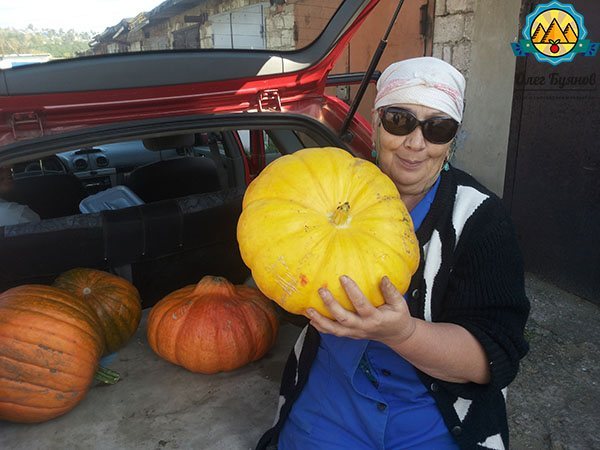

Fruits with a thick shell can be stored for several months, but the early varieties will have to be eaten shortly after harvest.
Classification of pumpkin varieties and the timing of their ripening
There are many varieties of pumpkin. By the timing of ripening, they are:
- early ripening (Freckle, Almond 35, Gymnosperms);
- mid-season (Russian woman, Kroshka, Smile);
- late ripening (Muscat, Vitamin, Pearl).
They are harvested in August, since they have the shortest ripening period - 3.5 months. Such a culture must be used within a month, it is no longer stored.
A little later (in the first decade of September), mid-season varieties are harvested, which ripen within 4 months and are also used mainly for consumption in the next two months.
For storage for the winter, late-ripening varieties with a thick peel are used. They begin to remove them from the garden at the end of September. A feature of these varieties is that the pumpkin reaches full ripening during storage (on average, 30-60 days after harvest).
Depending on the climate of the region where the pumpkin is grown, some shift in the timing of the harvest is allowed. For example, in the southern regions, where the first frosts come later, crops can stay on the beds longer.
There is one general rule of thumb when harvesting, regardless of the region: the pumpkin should be stored before the onset of frost.
How to harvest pumpkin and prepare it for storage
When you cut a pumpkin from the stalk, you must definitely leave a 4-7 cm tail on the fruit, so it will be better and longer to be stored. In this case, it is better to do this with a clean and sharp knife or pruner. The cut itself must be even, otherwise bacteria can get there, and rotting will begin.


Large fruits cannot be carried by the stalk, it can break off, so it is better to additionally hold it from below.
Now you need to look at the harvest, select all the healthiest and smoothest fruits, set aside the injured and deformed specimens separately, it is better to eat them first.
Advice! If during cleaning or storage you damaged the upper shell, then you can try to lubricate the damaged area with brilliant green or even stick a bactericidal plaster.
Video: how to harvest pumpkins
Pumpkin varieties. Large pumpkin
In large-fruited varieties of pumpkin, the fruits are large, contain a lot of sugar.Large-fruited pumpkins have a long shelf life. Popular and best varieties: Rossiyanka, Ambar, Zorka, Gribovskaya winter, Titan, Sweetie, Kherson, Smile. One of the features of the described pumpkin varieties is resistance to temperature drop.
Of the domestic varieties of large-fruited pumpkin, Mramornaya, Zolovaya Zimnaya, Gribovskaya Zimnyaya, Plastunovskaya, Prikornevaya are distinguished by high-quality lying fruits.
A widespread (from the southern to the north-western regions of the country) variety of hard-bore pumpkin is Almond 35, which has good quality fruits; bush early ripening varieties of this species are also cultivated - Luch and Gribovskaya bush.
Variety Rossiyanka
The juicy pulp has a pleasant melon aroma. The variety is early maturing, with a ripening period of 3 months. Pumpkins are large, yellow-orange, smooth, weighing up to 3 kg. The pumpkin of the Rossiyanka variety is resistant to extreme weather conditions (cold-resistant), has a high yield, and is lying.
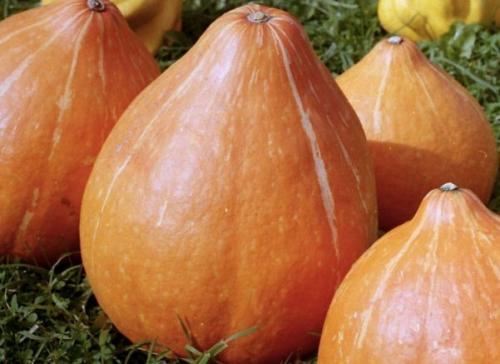

In the photo, a variety of pumpkin Russian woman
Dawn
Large-fruited "Zorka" is a medium-early variety, not susceptible to many diseases. The plants are vigorous and climbing. Fruits weighing about 5 kg have a flattened-rounded shape. The pulp of the pumpkin variety Zorka, although coarse, slightly juicy, but the taste is excellent. You can grow 300 kg of this pumpkin on a hundred square meters.
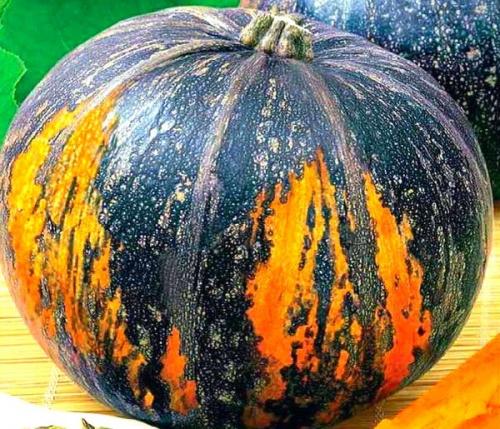

Photo "Dawn"
Harvesting pumpkin depending on the variety
In order to correctly determine the timing of harvesting this crop from your beds, you need to clearly know which variety you have to deal with. Pumpkin varieties are usually classified as follows:
Early ripening
... Such a pumpkin is considered ripe 92-104 days after planting, so harvesting is usually done in the second half of August. The varieties of this category are distinguished by their special tenderness, thin skin and short shelf life - no more than a month.
Mid-season
... These varieties of vegetables mature in the garden for 110 to 120 days. These varieties have a longer shelf life and a coarser texture. It is harvested from the second half of September until the first frost. After freezing, it will be poorly stored.
Late ripening
... A late-ripening pumpkin must be given about 200 days to fully ripen. However, it cannot be exposed to even a slight frost, which means that it should be removed from the beds by the end of September. It turns out that it is necessary to pluck an unripe vegetable, which will reach its peak of maturity during storage. Late-ripening pumpkin varieties are the most fragrant and sweet, but have a rough skin.
Only late-ripening pumpkin varieties can be stored for several months.
External signs of pumpkin ripeness will tell you when to harvest it.
The ripening dates of a certain pumpkin variety are indicated on the package for general orientation only. In reality, they can vary depending on the climatic zone and weather conditions in a particular year. So how can you tell if the yellow beauty in the garden is ready to clean? The following signs will help with this:
The stalk has become dry and stiff. The leaves of the bush turned yellow, and some even withered. The color of the pumpkin has become especially bright. The skin has become dense.
A withered stalk is the first sign of pumpkin ripeness
You need to remove pumpkins from the beds for storage only in dry weather. If it rains at a suitable time for harvesting, the vegetable should be thoroughly dried before storage.
Yellow fruits should be harvested especially carefully, avoiding damage, otherwise it will not work for a long time. Late-ripening varieties after harvesting need to be warmed up in the sun during the day, and then dried for about a week for better storage. Small scratches must be immediately lubricated with brilliant green. Seriously damaged fruit should be used in cooking first.
When harvesting the pumpkin, you need to leave 3-4 cm of the stalk
When to remove pumpkin from the garden, it will help to determine the knowledge of its varietal affiliation. But to establish more accurately that a vegetable is ready for consumption or storage will prompt certain signs of maturity.Growing pumpkin in general and determining the timing of its harvest in particular is not particularly difficult. It is possible to have such a valuable food product on your table without much labor costs.

